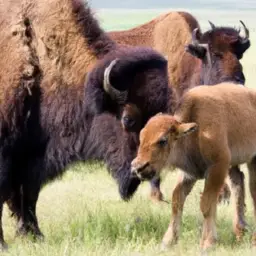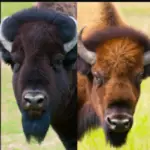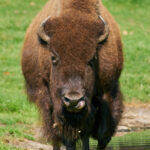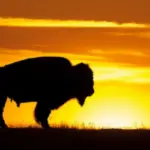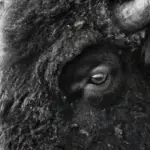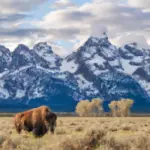Have you ever found yourself wondering about the collective name for a group of bison? Look no further, as “What Is A Group Of Bison Called” is here to provide you with the answer! This intriguing product will not only satisfy your curiosity but also provide a fascinating exploration into the world of bison and their unique group dynamics. Whether you’re a nature enthusiast or simply seek knowledge about the animal kingdom, “What Is A Group Of Bison Called” is the perfect resource to quench your thirst for interesting trivia. Get ready to embark on a journey of discovery and unravel the mysteries behind these magnificent creatures.
Understanding Bison Behavior
The solitary nature of male bison
Male bison, also known as bulls, are typically solitary creatures. They prefer to roam alone, covering vast distances in search of food, water, and mates. This solitary behavior is most evident during the breeding season when male bison actively seek out females and compete for dominance. Bulls establish their own territories and mark them with scent markings to deter other males from encroaching. This solitary nature allows male bison to conserve energy and resources while focusing on their reproductive efforts.
The gregarious nature of female bison and young ones
In stark contrast to their male counterparts, female bison, also known as cows, and their young ones exhibit a highly gregarious nature. They form social groups called herds, which provide protection, support, and increased chances of survival. These herds usually consist of multiple cows, their calves, and sometimes young bulls who haven’t yet reached sexual maturity. The bond between cows and their offspring is particularly strong, with the cows fiercely defending and nurturing their young ones.
Bison’s migratory behavior
Bison are known for their migratory behavior, especially in response to seasonal changes and the availability of resources. This behavior is driven by the need to find adequate grazing grounds, avoid extreme weather conditions, and ensure the survival of the herd. Bison herds can cover great distances during their migrations, traversing vast grasslands and even crossing rivers or mountain ranges. These migrations play a crucial role in maintaining the health and diversity of the bison population and their surrounding ecosystems.
Introduction to Bison Herds
Size of bison herds
Bison herds can vary greatly in size, ranging from a few individuals to several hundred or even thousands. The size of a herd often depends on factors such as the availability of food, water, and suitable habitat. Larger herds are commonly found in areas with abundant resources, while smaller herds may be seen in more limited environments. The size of a herd can also fluctuate throughout the year due to migrations or changes in the population’s reproductive dynamics.
Composition of bison herds
Bison herds are typically composed of adult cows, their offspring, and sometimes young bulls. The social structure within the herd is hierarchical, with dominant individuals exerting their influence and ensuring order. Cows usually form the core of the herd and take on the responsibility of protecting and nurturing their young ones. Young bulls, on the other hand, may either remain within the herd until they reach sexual maturity or form small groups of their own as they explore their independence.
Purpose of bison herds
The primary purpose of bison herds is to provide mutual support and protection for their members. By sticking together, they increase their chances of survival against predators, and collectively, they can defend themselves more effectively. The herds also serve as vital social units for breeding and raising young, as they offer a supportive environment for mating rituals, gestation, and the upbringing of calves. Additionally, these herds play a crucial role in the overall health and balance of the ecosystems they inhabit.
Terminology for Bison Groups
Definition of a herd
A herd is the term commonly used to refer to a group of bison, regardless of size or composition. It encompasses the social groups formed by cows, their offspring, and sometimes young bulls. Through this collective term, we recognize the significance of the bonds and interdependencies within bison groups and the shared experiences they undergo.
Other terms used for bison groups
Apart from the general term “herd,” there are specific terms used to describe certain configurations or aspects of bison groups. A “bachelor group” refers to a group of young bulls who have not yet established their own territories or joined a larger herd. They often engage in social bonding and playfulness as they grow and mature. The term “calving group” is used to describe a subset of a herd consisting of pregnant cows and their calves. This specialized group provides additional support and protection for the vulnerable newborns.
Leadership in Bison Herds
Role of the dominant male
Within a bison herd, the dominant male, often referred to as the herd bull or alpha bull, plays a crucial role in maintaining order and preserving reproductive rights. The alpha bull is typically the largest and most physically imposing male in the herd. He establishes his dominance through displays of aggression and vocalizations, asserting his authority over other males and defending his breeding privileges. The alpha bull also takes on the responsibility of protecting the herd from potential threats and leading them during migrations or in search of resources.
Role of the dominant female
While the dominant male leads the herd, the dominant female, also known as the matriarch, holds a position of influence over the other females. She is usually an older, experienced cow who has earned her status through strength, intelligence, and successful reproduction. The matriarch guides the herd’s movements, helps make important decisions, and ensures the well-being of the members. She also takes a leading role in defending the herd against predators and other potential threats.
Changing leadership within a herd
Leadership roles within a bison herd can change over time due to various factors such as age, health, and physical condition. As bulls grow older and weaker, new challengers may rise to challenge their dominance and claim the position of alpha bull. Similarly, the role of the dominant female may be passed on to a younger cow who has proven herself capable of assuming the responsibilities of leading the herd. These leadership transitions are essential for maintaining the herd’s vitality and adaptability.
Social Interactions within Bison Herds
Social ranking
Social ranking plays a significant role within bison herds, establishing a hierarchy that determines access to resources and opportunities to reproduce. Dominance is primarily determined by age, size, and physical strength. The alpha bull holds the highest rank among the males, followed by younger bulls in a descending order. Among the females, the dominant cow, often the matriarch, commands respect and takes precedence in decision-making and accessing resources. This social ranking reduces the need for aggressive confrontations and maintains order within the herd.
Interactions between males
While male bison may generally have solitary tendencies, they engage in various social interactions when their paths cross. These interactions can range from friendly to aggressive, depending on the context and the males’ objectives. Bulls may engage in displays of strength and dominance, such as parallel walking, head-butting, or rubbing their scent glands on objects to mark their territories. These interactions help establish and reinforce the social hierarchy among the males.
Interactions between females and young ones
Females and their young ones in a bison herd engage in intense social interactions that foster coordinated care and support. Young calves engage in play behavior, which serves as a means of developing social skills, strengthening bonds, and promoting physical fitness. The cows also exhibit strong maternal instincts, nursing their young, grooming them, and fiercely protecting them from potential predators. These interactions create a nurturing and supportive environment within the herd and contribute to the overall cohesion and survival of individual members.
Territorial Behavior in Bison
Marking territory
Territorial behavior is a critical aspect of bison behavior, particularly among males. Bulls mark their territories through various means, including rubbing their scent glands on trees or rocks, urinating, and rolling in mud or dust to leave their distinct scent. These scent markings serve as a warning to other males, indicating that the territory is claimed and defended. By marking their territories, bison reduce the need for direct physical confrontations and minimize the risk of injury or energy expenditure.
Defense of territory
Once a bull has established a territory, he becomes fiercely protective of it. Bulls will actively patrol and defend their boundaries against potential intruders, engaging in aggressive displays and vocalizations to deter rivals and assert their dominance. These territorial defenses are essential for maintaining breeding rights and ensuring the survival of their genetic lineage within the herd.
Fights for territory among males
In some cases, territorial disputes among bison escalate into physical fights. When two bulls of similar strength and size encounter each other within disputed boundaries, they may engage in head-on combat. These fights involve charging, head-butting, and clashing horns, creating a spectacle of power and determination. The winner of such confrontations establishes his dominance and gains control over the territory, while the less successful male is forced to retreat and seek opportunities elsewhere.
Communication in Bison Herds
Visual signals
Bison also utilize various visual signals to communicate with each other within the herd. One of the most notable visual displays is the raising of the tail. When a bison raises its tail, it indicates agitation or potential danger, serving as a warning to other members of the herd. Additionally, males may engage in visual displays of dominance, such as lowering their massive heads, pawing the ground, or stiffening their bodies to establish their authority.
Vocal communication
Bison communicate through a range of vocalizations, each conveying different messages. The most common vocalization is the low, resonant bellow emitted by males during the breeding season, signaling their readiness to mate and asserting their dominance. Cows also emit soft grunts and contact calls to communicate with their calves or other members of the herd. These vocal cues allow bison to stay connected and coordinate their movements and responses within the group.
Olfactory signals
The sense of smell is highly developed in bison, and they utilize olfactory signals to communicate important information. Scent marking is a prevalent behavior, as males leave behind pheromones and markings to establish their territories and communicate their reproductive status. The females also rely on smell to recognize and bond with their calves, using their distinct scents to navigate within the herd. Olfactory signals play a vital role in reinforcing social bonds and defining the dynamics of the herd.
Reproduction and Breeding in Bison Herds
Mating rituals
Breeding in bison herds is an intense and competitive process. During the mating season, dominant males actively seek out receptive females and compete for their attention. The males engage in displays of strength and dominance, including digging up the ground, wallowing in dust, and vocalizing loudly. These displays attract the attention of females, who carefully evaluate potential mates before making their choice. Once a female has made her selection, mating occurs, leading to the fertilization of the eggs and subsequent development of the calf.
Gestation period and birth
The gestation period for bison is approximately nine months, similar to that of domestic cattle. Throughout this period, the pregnant cow remains within the herd, receiving protection and support from other females. As the time of birth approaches, the cow seeks out a secluded area away from the main herd to give birth. The female bison typically gives birth to a single calf, which is born precocial, able to stand and walk within a short time. This ensures the calf’s survival and reduces vulnerability to predators.
Role of the herd in upbringing of young ones
Bison herds play a crucial role in the upbringing of young calves. Once born, the calf remains under the watchful eyes of its mother and the other females in the herd. The cows form a collective nursery, where multiple calves are cared for, allowing the mothers to take turns grazing and providing protection. This shared responsibility increases the chances of survival for the young ones, as they benefit from the collective knowledge, experience, and vigilance of the herd. The robust social structure within the herd contributes to the successful rearing and integration of the calves into the bison population.
Role of Bison Herds in Ecosystems
Bison as keystone species
Bison are considered a keystone species within their ecosystems, meaning they have a disproportionately large impact on their environment compared to their population size. The grazing behavior of bison plays a crucial role in shaping the landscape by maintaining grasslands, promoting plant diversity, and preventing the encroachment of unwanted woody plants. Their grazing also helps cycle nutrients and seeds, benefiting numerous other plant and animal species that depend on healthy grassland habitats.
Bison’s effect on plant diversity
The selective grazing habits of bison have a direct influence on plant diversity and composition within their habitat. By selectively consuming certain grasses and plants, bison prevent the dominance of a single plant species and promote a more diverse range of vegetation. This diverse plant community provides a habitat for various insects, birds, and other herbivores, creating a balanced and resilient ecosystem. By enriching the plant diversity, bison contribute to the overall health and sustainability of their surroundings.
Bison’s interaction with other animals
Bison herds interact with other animals in their ecosystems, shaping the dynamics of the entire community. Their grazing activities create open spaces and nutrient-rich patches that attract a wide variety of other herbivores, benefiting species such as pronghorn antelope, ground-nesting birds, and small mammals. Additionally, bison wallows, created by rolling in mud or dust, provide watering holes for other animals and serve as vital habitats for amphibians and insects. The presence of bison within an ecosystem fosters biodiversity and promotes the interconnectedness of species.
Does the Group of Bison Have a Specific Name Based on Their Biome?
Yes, the group of bison living in a specific biome is called a herd. These impressive animals roam the grasslands and prairies, forming herds that can contain hundreds of individuals. The biome of bison live in greatly influences their behavior and characteristics.
Threats to Bison Herds
Human activities
Human activities have long posed a threat to bison herds. Historically, bison populations faced a severe decline due to commercial hunting, habitat destruction, and the introduction of diseases by domestic livestock. Although conservation efforts have led to the recovery of bison populations in some areas, they still face ongoing challenges such as habitat fragmentation, conflicts with agricultural practices, and limited genetic diversity.
Predators
Predators, particularly large carnivores such as wolves and bears, pose a threat to bison herds, especially vulnerable calves. These predators often target weak or injured individuals, exploiting the opportunities provided by large groupings of bison. The presence of predators helps maintain a balanced ecosystem and speaks to the complex relationships within nature, but it can also impact the survival and reproductive success of the bison.
Illnesses or diseases affecting the bison herd
Bison herds are susceptible to various illnesses and diseases that can significantly impact their population. One of the most notable diseases is brucellosis, which can cause reproductive issues among bison and have wider implications for the livestock industry. Other diseases, such as pneumonia or chronic wasting disease, also pose risks to bison herds, compromising their health and overall population viability. Appropriate management strategies, including vaccination programs and monitoring, are essential for mitigating disease risks and protecting the long-term survival of bison herds.
In conclusion, understanding the behavior and dynamics of bison herds is essential for their conservation and the preservation of their vital role within ecosystems. From the solitary nature of male bison to the gregarious tendencies of females and young ones, each aspect contributes to their collective survival and well-being. Through intricate social interactions, territorial behavior, and communication, bison herds maintain order, coordinate their movements, and ensure successful breeding and raising of young calves. As keystone species, bison have lasting impacts on plant diversity and the interactions within their ecosystems. However, they face ongoing threats, primarily due to human activities, predation, and the risks associated with diseases. By appreciating and safeguarding the intricate lives and behaviors of bison herds, we can protect these majestic animals and enable them to continue thriving in their natural habitats.

